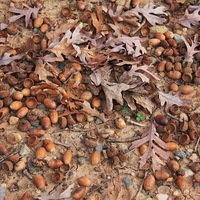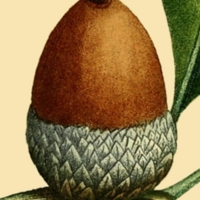White Oak : White Oak Acorns
White oak acorns are especially useful because they sprout rapidly and are very adaptable and resilient. Many animals rely on acorns as a source of nourishment. Squirrels are commonly known to eat and store acorns, but many other animals use the acorns as well. Deer, bears, raccoons, turkeys, ducks, blue jays, woodpeckers, and wild boars are just some of the animals that rely on white oak acorns.
There is archaeological proof that humans have eaten white oak acorns for many years. Evidence shows that during the Woodland Period, as early as 900 BC, humans were using acorns as a source of nourishment. White oak acorns are low in fat and protein but are high in carbohydrates, resembling the nutritional value of corn. Therefore, when corn became a major crop around 1000 AD, or during the Mississippian Period, the need for acorns diminished. Although corn became a major crop, white oak acorns were still gathered during times of food shortage.
White oak acorns are prepared in various ways depending on the culture. Cherokees strained baskets of acorns with water and then boiled the acorns to remove the oil. They would then use the acorn remains to make flour. Other tribes, including the Apaches, Comanches, Tonkawas, and Caddoan gathered and used acorns as a form of nutrition. Acorns have also been used for soups, breads, and pancakes.


